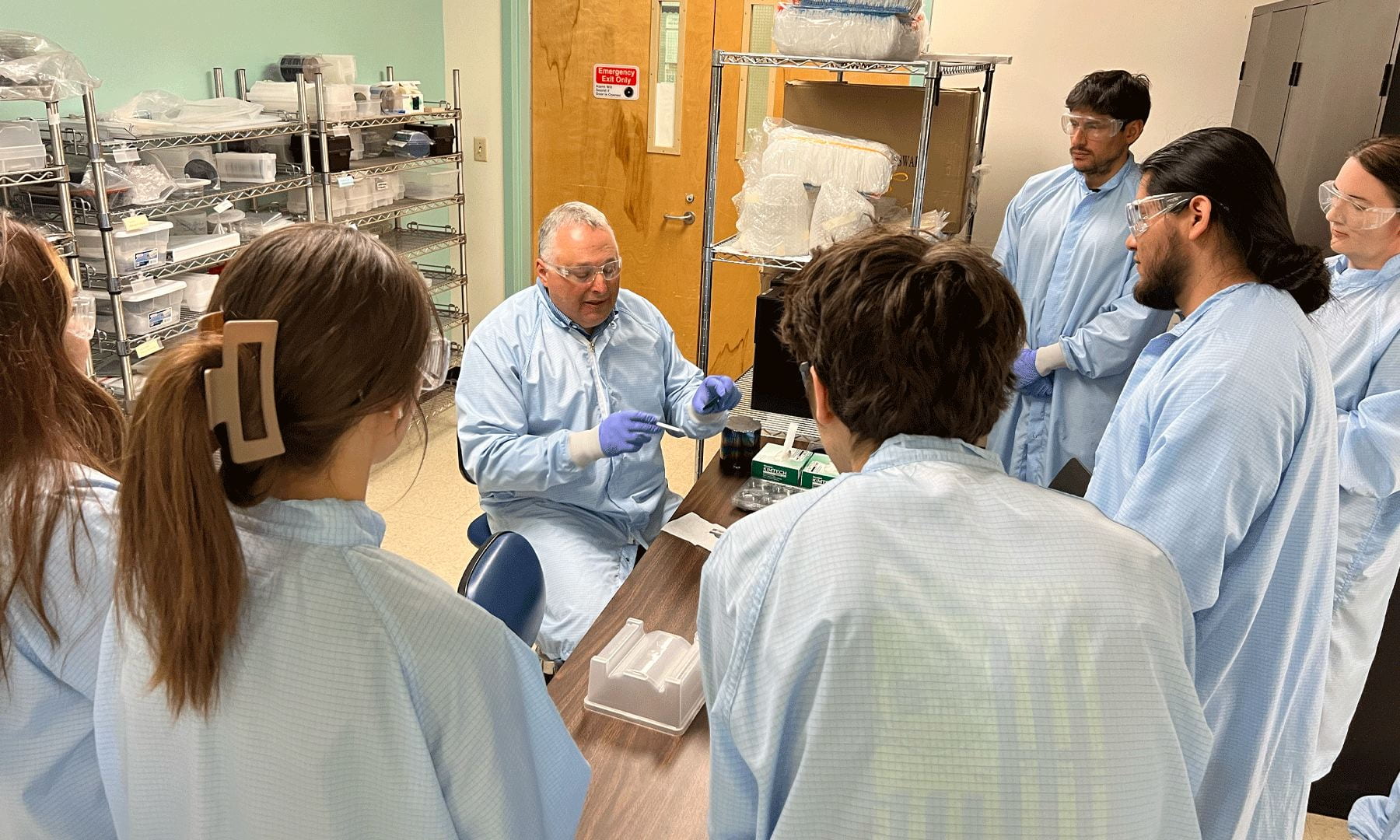HSI Project Engineering Success to Help Hispanic and Low-Income Students Thrive in STEM

David Parent demonstrates engineering concepts to Gavilan Community College Students as part of Project Engineering Success. Photo by Eugenia Ayala-Servellon.
When it comes to education, there can be many barriers to success, particularly for Hispanic and low-income students. First-generation students might not know about office hours, for example, or the best classes to take at a community college in order to transfer to SJSU and graduate in four years.
Project Engineering Success, part of a five-year, $5 million grant from the U.S. Department of Education to help Hispanic and low-income (Pell Grant eligible) students navigate college on their way to careers in engineering and computer science, seeks to right this wrong in what David Parent, professor of electrical engineering at San José State University, calls “an inclusive and understanding manner.” In order to do this, SJSU has partnered with two local community colleges, San José City College and Gavilan College, that have a high percentage of both Hispanic and low-income students.
Parent is the effective PI for the grant, along with SJSU Provost and Senior Vice President for Academic Affairs Vincent del Casino, Jr., and Liat Rosenfeld, associate professor of chemical and materials engineering, who is a senior personnel member for the grant. The program is in its third year.
The program addresses various problems from different viewpoints, using five “activities” to help both faculty and students navigate the challenges of learning and teaching engineering. The activities are as follows:
1) Research Projects
STEM community college students from San José City College and Gavilan Community College are invited to apply for paid summer internships at San José State, where they work with engineering and computer science faculty on various research projects which they then bring back to Gavilan and SJCC for poster sessions. The hope, Parent says, is that this will lead them to continue their studies at SJSU.
When students enroll at SJSU, semester-long research internships are also available, and are advertised to Hispanic and Pell grant recipients first. Students are paired with a faculty mentor for a semester-long research project that culminates in a poster day at the end of each semester.
2) Expansion of MESA
The Mathematics Engineering Science Achievement (MESA) program is already well-established at SJSU. Students have access to many resources including advising, peer mentoring, study sessions, professional development courses on topics like resumé development and more.
Funding from Project Engineering Success will ensure the continuation of Gavilan’s own MESA program, and help SJCC create their own MESA program as well. As part of this expansion, Parent travels to both campuses to give talks to the students and inform them about the Project Engineering Success program.
3) Three-Day Summer Faculty Workshop
On the faculty side, Parent hosts a three-day summer faculty workshop to help SJCC, Gavilan and SJSU faculty learn “how to use universal design for instruction to reduce any barriers for learning” that might exist for these students. The emphasis, Parent says, is on clarity. Many of these students are first-generation, and this activity “will give faculty the skills to better engage students in their courses.”
In addition, Parent gives technical workshops to community college faculty on various topics like circuit design and artificial intelligence that they can then bring back to their own classrooms.
4) Model Transfer Curriculum Pathways
Another barrier to student success, Parent explains, is the transfer process — it’s difficult for students to know which courses they need to complete both at the community college and at SJSU in order to finish their specific degrees on time, particularly when course numbers are different between colleges.
Activity 4’s Model Transfer Curriculum Pathways offer a simple solution: creating major-specific road maps for students at both community colleges that detail precisely which courses they need to take and when in order to graduate on either a four- or five-year timescale. Parent and his team posted the lists on community college and SJSU websites so that students can see and follow a clear path to graduation.
5) Outreach Events
Along with the various outreach events through MESA, Parent and others will help run and organize outreach events between industry and the colleges, including SJSU Career Center workshops and opportunities for students to network with companies and find out more about employment opportunities. There will also be a career day with a semiconductor organization.
“This program has given me the resources to help over 500 students and at least 30 faculty,” Parent says. “It’s shown me that lower division students can participate in authentic research activities, and I have had a lot of fun doing it.”
The student perspective
Student participants are equally enthusiastic.
Michael Pitta, ’25 Electrical Engineering, says that Project Engineering Success “has been great at helping me bridge the gap between education and work. Our research and meetings with Dr. Parent are treated more as what would be expected in an employer/employee relationship, which is valuable experience in not only learning how to conduct and record research, but also preparation for the less guided experience of employment as an engineer.”
“I am a transfer student and had not previously participated in workshops or undergraduate research. This program allows me to gain experience that does not usually come with an undergraduate degree. The workload is quite high, but also rewarding.”
Vedika Sharma, ’27 Electrical Engineering, agrees: “My experience with Project Engineering Success has been phenomenal.”
She’s working on a research project with Parent, which she says has “provided me with a head start in my academic journey, exposing me to the fundamentals of electrical engineering at an early stage.
“Programs like Project Engineering Success serve as a gateway for students to enter the versatile and expansive field of STEM, not only enhancing their technical skills but also providing a great deal of experience outside the classroom where students can grow and learn.”




